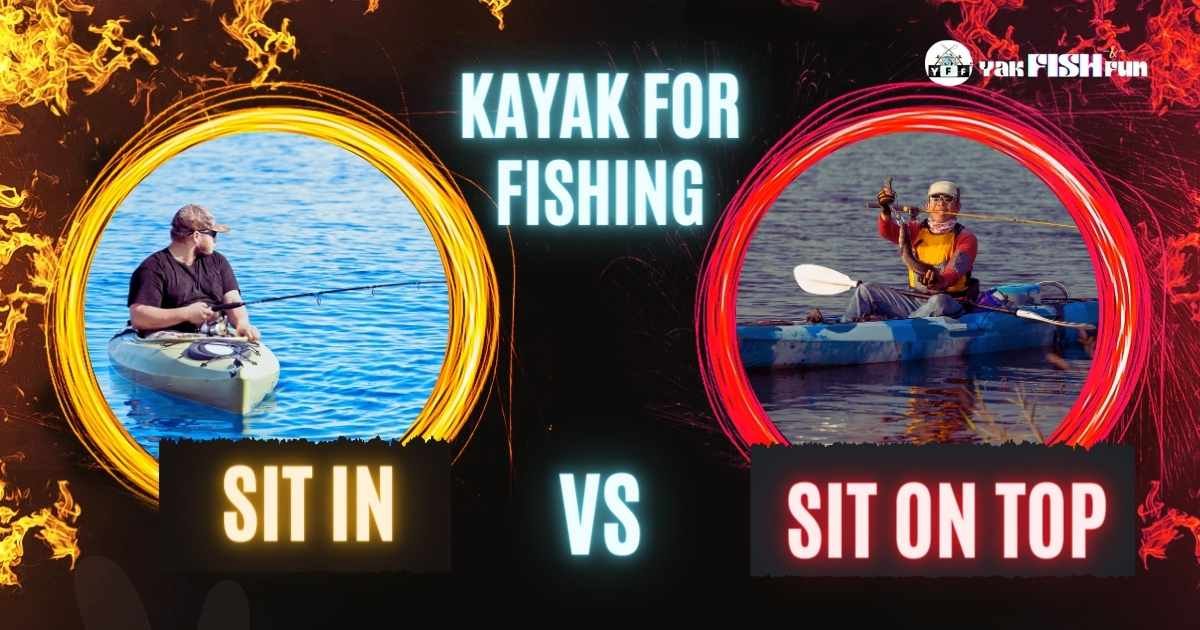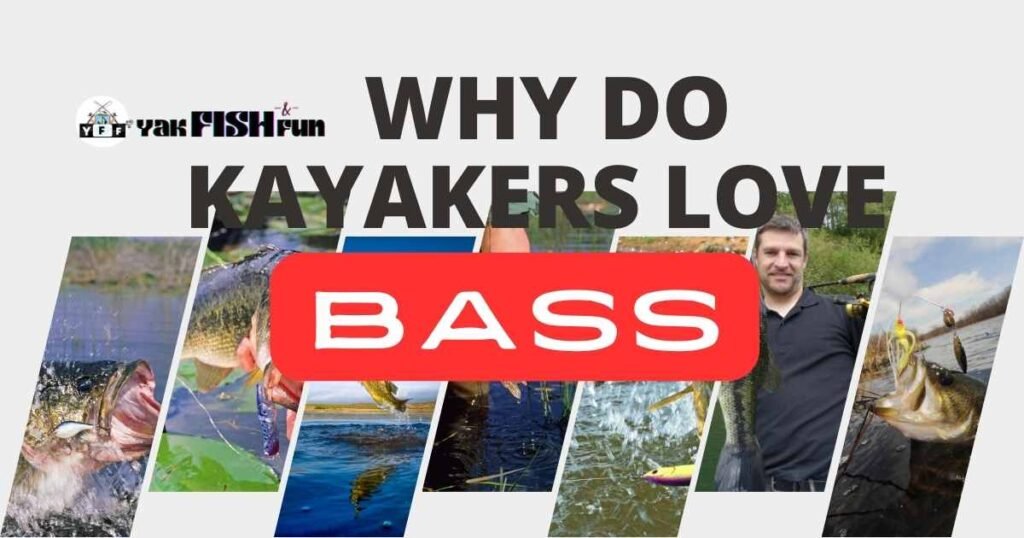Kayak fishing is an exhilarating way to immerse oneself in the serenity of open waters while chasing the thrill of a catch. However, choosing the right kayak for this endeavor can be daunting.
So, we’re introducing the age-old debate: Sit-In vs. Sit-On-Top Kayak for Fishing. It’s a choice that can significantly impact your angling adventures.
Choosing the ideal kayak extends beyond mere aesthetics or brand names. It’s about understanding design, functionality, comfort, and how they align with your fishing style and environment. Your kayak is your fishing partner, and investing wisely will enhance your enjoyment and success on the water.
Both of them offer unique advantages and disadvantages that can significantly impact an angler’s experience on the water.
In this article, we’ll dive into the world of kayaks, breaking down the pros and cons of both sit-in and sit-on-top designs when it comes to fishing. We understand that everyone has different needs based on their fishing style and the type of waters they navigate.
Let’s explore who wins, sit in, or sit on for fishing.
Table of Contents

Comparing Sit-on-Top vs Sit-in Kayaks For Fishing
Sit-on-top kayaks and sit-in kayaks are two popular options for anglers looking to enjoy a day on the water. Each type has its own set of advantages and disadvantages, making it important to understand which one suits your needs best.
Let’s compare these two based on their advantages and downsides.
Advantages of Sit-on-Top Kayaks for Fishing
Sit-on-top kayaks are the top choice for fishing due to their stability and ease of use. These kayaks provide a comfortable, open seating area, allowing fishermen to move freely. With their user-friendly design, anglers can easily navigate through different fishing spots without worrying about tipping over or feeling restricted.
Related: Why Are Fishing Kayaks Sit On Top?
Stability and Ease of Use
One of the key advantages of sit-on-top kayaks is their exceptional stability. Unlike traditional kayaks, which require a skilled balancing act, sit-on-tops offer a wider hull that increases water stability. This means that even novice anglers can confidently paddle and fish without the fear of capsizing.
Moreover, these kayaks have a lower center of gravity, making them less prone to tipping over. This stability is particularly advantageous when reeling in larger fish or dealing with choppy waters. Anglers can focus on their catch without constantly worrying about maintaining balance.
Comfortable and Open Seating Area
Sit-on-top kayaks have a big, open seat that’s super comfy for long fishing trips. Unlike regular kayaks, they don’t have a covered space, so you can easily move around and stretch your legs while you’re fishing.
Because they’re so open, they’re great for hot weather. You’ll stay cool because there’s lots of air getting to you. This is especially beneficial in warm climates where excessive heat can quickly become exhausting.
Self-Draining Design
Another significant advantage of sit-on-top kayaks is their self-draining design. These kayaks have special holes called scupper holes on the bottom. These holes are put in the right places to make sure any water that gets inside the kayak flows out. This stops water from building up inside the kayak and keeps the people fishing in it nice and dry.
Having these holes means you don’t have to scoop water out of the kayak yourself when there are big splashes or waves. You can concentrate on your fishing and not worry about getting rid of the water inside the kayak.
Easy Gear Access and Standing Capabilities
Sit-on-top kayaks are great for fishermen because they make it easy to get to your gear. You can quickly grab your stuff or switch out your fishing gear while you’re still on the move. These kayaks have plenty of space on the deck and various storage options so that you can keep your important things nearby. This makes fishing super smooth and easy.
Even better, you can stand up in these kayaks to see better when you’re casting your line or trying to find fish. Being higher up helps you aim more accurately and see underwater stuff or schools of fish more clearly. Standing up gives your body a break from sitting for a long time and lets you move around better when you’re fishing or reeling in your catches.
Disadvantages of Sit-on-Top Kayaks for Fishing
When it comes to fishing from a kayak, sit-on-top kayaks are a popular choice for many anglers. However, despite their advantages, they also come with a few disadvantages that should be taken into consideration.
Let’s explore a few downsides of it:
Exposure to Elements
Sit-on-top kayaks, while popular for fishing, come with their fair share of disadvantages. One major drawback is the exposure to the elements. Sit-on-top kayaks are different from sit-in kayaks because they’re more open. You’re more exposed to the sun, wind, and water splashes when you’re in a sit-on-top kayak. This can make you less comfortable, especially when it’s really sunny or windy. People using sit-on-top kayaks for fishing might have to deal with these elements a lot, which can make it tougher to have a great time fishing.
Limited Suitability for Cold Weather
There are better choices than sit-on-top kayaks for fishing when it’s cold. They have an open design, so you’re right out there with the cold water and wind. This can make fishing uncomfortable, and it might be unsafe in cold places. Because there’s no cover, you don’t have any protection from icy water or chilly winds. This can make you feel cold and uncomfortable fast, and it might even be dangerous if you’re not ready.
Potential for Water Splashing
Sit-on-top kayaks are more likely to get splashed with water than sit-in kayaks, especially when it’s choppy or windy. The reason is that sit-on-top kayaks are open on top, so waves and splashes can come inside more easily. This means you might end up getting wet when you’re out fishing. It’s not just about getting wet, though; it could also ruin your fishing gear or stuff you have with you because they might get wet, too.
Consider Speed and Efficiency
Sit-on-top kayaks may need to catch up to their sit-in counterparts. This happens because they have a wider shape and more surface area that catches the wind, making it harder to paddle efficiently and move quickly. So, if you’re using a sit-on-top kayak for fishing, you might not be able to cover as much distance as you would with a sit-in kayak. It can be especially tough to reach fishing spots that are far away or if you need to paddle against strong currents.
Convey Limited Storage Options
When it comes to storing your stuff, sit-on-top kayaks are better than sit-in kayaks. Sit-on-top kayaks are open on top, so there’s less room to put your fishing gear, tackle boxes, and other important things. If you like to bring a lot of equipment with you, it might take a lot of work to fit it all in a sit-on-top kayak. This can be not very pleasant, and you’ll need to plan carefully and decide what gear is most important for each fishing trip.
Advantages of Sit-in Kayaks for Fishing
Sit-in kayaks are great for fishing. They have a special seat inside the kayak, so you sit down in it. This makes it really stable and safe for fishing. Like a roof, the kayak has a cover that protects you from the wind, rain, and sun, so you can fish comfortably even when the weather isn’t great.
Let’s explore a few advantages of it:
Better Protection from the Elements
Sit-in kayaks are great for keeping fishermen safe from the weather. They have a cover that protects you from the wind, rain, and water splashes so that you can have a more comfortable time on the water. This is helpful when the weather is bad, or you’re fishing in cold places.
You can also add something called a spray skirt to the cockpit area of a sit-in kayak. It helps stop water from getting inside the kayak. This is super useful when the water is rough or if big waves might soak you in an open-top kayak.
Increased Stability and Control
Sit-in kayaks are great for fishing because they are super stable and easy to control. These kayaks are designed to keep the center of gravity low so that they won’t tip over easily on the water. This means you can focus on fishing without worrying about falling in.
The closed-off cockpit also helps you control the kayak better. You can use your legs against the inside walls to help steer and move around while you paddle or get in position to catch a fish. This extra stability and control make sit-in kayaks perfect for both beginners and experienced anglers.
Suitable for Cold Weather Fishing
Sit-in kayaks are a great pick if you like fishing in cold weather because they have a closed design. The part where you sit is covered, so it shields you from cold winds and helps your body stay warm during your fishing trips.
Also, with sit-in kayaks, you can wear special drysuits or wetsuits under your regular clothes without getting too cold from the air or water. This makes it much easier to stay comfy and concentrate on catching fish, even when it’s cold outside.
Easy Access to Gear and Equipment
Fishing in a sit-in kayak provides the advantage of easy access to gear and equipment. In sit-in kayaks, the covered space lets you keep all your fishing stuff like tackle, fishing rods, and other important things close to you. You don’t have to keep reaching far back or around to grab them, which makes things much easier and quicker when you’re on the water.
Some sit-in kayaks even have special storage areas or hatches built into them. You can use these to safely keep extra gear, like more fishing lines, containers with bait, or your personal stuff. These compartments help keep everything organized and readily accessible during a fishing expedition.
Disadvantages of Sit-in Kayaks for Fishing
Sit-in kayaks can be popular for fishing enthusiasts due to their stability and maneuverability. However, they also come with a few disadvantages that potential buyers should consider.
Let’s have a look at them:
Limited storage space inside sit-in kayaks for fishing
One big problem with using a sit-in kayak for fishing is that it only has a little room for storing your stuff. Unlike sit-on-top kayaks that often have a big open area, sit-in kayaks have a small space where you sit, and there’s little room for your gear and equipment. This can be a real issue for fishermen who need a bunch of tools and accessories when they’re on the water.
Related: Are Sit Inside Kayaks Good For Fishing?
It’s super important to have enough space to keep all your things. Fishermen have to carry lots of stuff like tackle boxes, fishing rods, reels, bait, and safety gear. But in a sit-in kayak, you have to carefully organize everything in the small compartments or tie them down with bungee cords on the deck. This lack of space can be really frustrating and inconvenient when you need to grab a specific piece of gear quickly.
Difficulty in accessing gear and equipment while seated inside a sit-in kayak
Using a sit-in kayak for fishing has another problem besides not having much storage space. Getting to your gear and equipment when you’re sitting inside is difficult. Different from sit-on-top kayaks, where everything is easy to reach, if you’re using a sit-in kayak, you might find it hard to grab the important stuff you need while you’re fishing.
In kayaks, reaching stuff behind or under the seats can be tricky because the kayak is small. Fishermen might have to twist their bodies a lot or even partly get out of the kayak just to get their gear. This isn’t just distracting; it also makes it more likely that the kayak could tip over or that the person could lose their balance.
Restricted movement and flexibility for anglers inside sit-in kayaks
Sit-in kayaks restrict movement and flexibility for anglers compared to their sit-on-top counterparts. The enclosed design of sit-inside models limits legroom and hampers natural body movements required during fishing activities.
Anglers often need to shift their weight, adjust their seating position, or stand up for better casting or reeling. However, inside a sit-in kayak, these movements are constrained by the cockpit’s narrow space and the presence of foot braces. This lack of freedom can impede an angler’s ability to maneuver effectively and comfortably while fishing.
Increased risk of capsizing or swamping due to the enclosed design of sit-in kayaks
Using sit-in kayaks for fishing has a big problem: they can easily tip over or get filled with water. Even though the design keeps you safe from the wind and water, it can also be risky.
If a sit-in kayak gets filled with water because the water is rough or you didn’t use the right technique, it’s hard to get the water out. And if the kayak flips over, it’s tougher to get out of it compared to sit-on-top kayaks, which are easier to get back into after flipping. This extra risk can be worrying, especially if you’re new to kayaking or you’re going into unpredictable waters.
Determining The Best Type of Kayak for Your Fishing Needs: Sit in or sit on
In our earlier talk, we discussed the good and not-so-good things about sit-in and sit-on kayaks for fishing. Now, let’s go into the practical stuff and things to think about that will help you figure out which type of kayak is best for your fishing needs.
Related: Can You Fish From A Sit-In Kayak? How Do They Perform In Fishing?
Fact 1: Calm Lakes and Slow Rivers:
A sit-in kayak may be a better choice if you primarily fish in calm lakes or slow-moving rivers. Sit-in kayaks offer excellent stability, protection from the elements, and a drier fishing experience. They are well-suited for leisurely fishing in peaceful waters.
Fact 2: Rough Waters and Ocean Fishing
However, if your goal is to go into more challenging waters, like ocean fishing, then a sit-on-top kayak is the better choice. Sit-on-top kayaks are really good for this. They’re easy to steer and don’t hold onto water, and if you tip over, getting back on them is simple.
Fact 3: Casting and Stand-Up Fishing:
If you prefer casting long distances, engaging in stand-up casting or need ample space to move around while fishing, a sit-on-top kayak provides more room and flexibility. You’ll have an open deck for casting and can easily transition from sitting to standing.
Fact 4: Precision and Control
If your fishing style involves precision maneuvering, navigating through tight spots, or requiring better control over your movements, a sit-in kayak with its enclosed cockpit may offer the stability and control you need.
Fact 5: Mobility and Comfort:
Assess your mobility and comfort level in a kayak. If you have limited mobility or find it challenging to enter or exit a kayak with an enclosed cockpit, a sit-on-top kayak offers easier access and greater freedom of movement.
So,
- A sit-in kayak may be ideal if you primarily fish in calm lakes or slow rivers and prioritize stability and protection.
- If you venture into rough waters, engage in stand-up casting, or need ample storage, a sit-on-top kayak is a strong choice.
- Precision maneuvering and control may lead you to prefer a sit-in kayak.
- Your budget, mobility, and environmental considerations should also play a role in your decision.
Bottom Line: Sit Inside vs Sit On Top For Fishing
In summary, whether you should pick a sit-inside kayak or a sit-on-top kayak for fishing depends on what you like and what you need. Sit-on-top kayaks have some good things, like they’re easy to get in and out of, stable, and can drain water easily. They work well in warm weather and if you like the open design.
But if you want more protection from the weather, better control, and more storage, then sit-inside kayaks are better. They’re good for colder places or rough waters.
To make a smart choice, think about the weather where you’ll be fishing, the kind of water you’ll be on, how much experience you have, and what kind of kayak you’re comfortable with. It’s a good idea to try both types of kayaks if you can, so you can see which one feels better and suits your fishing style.


